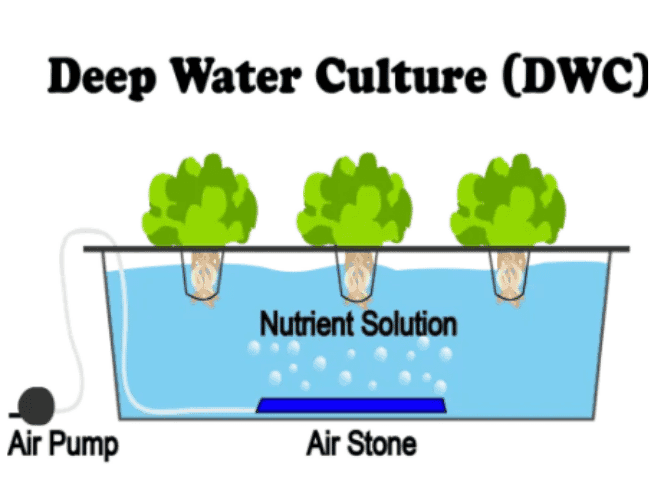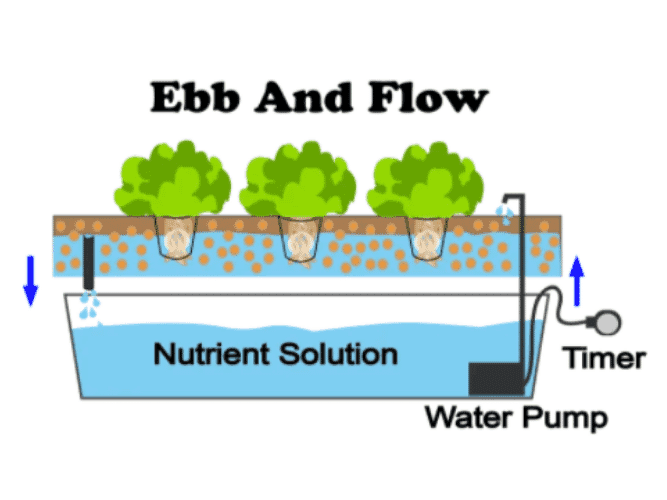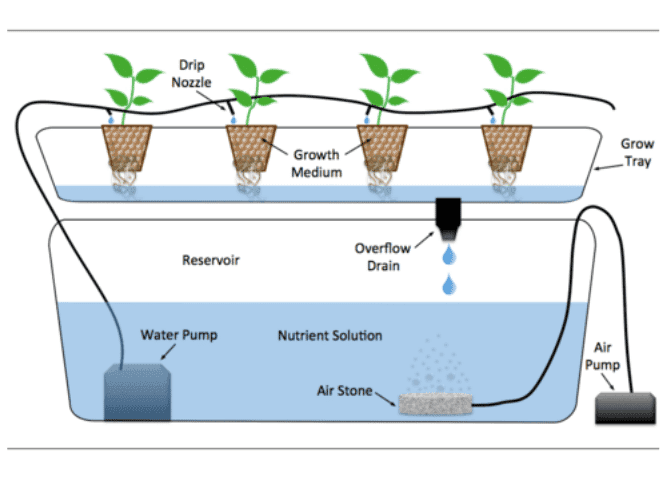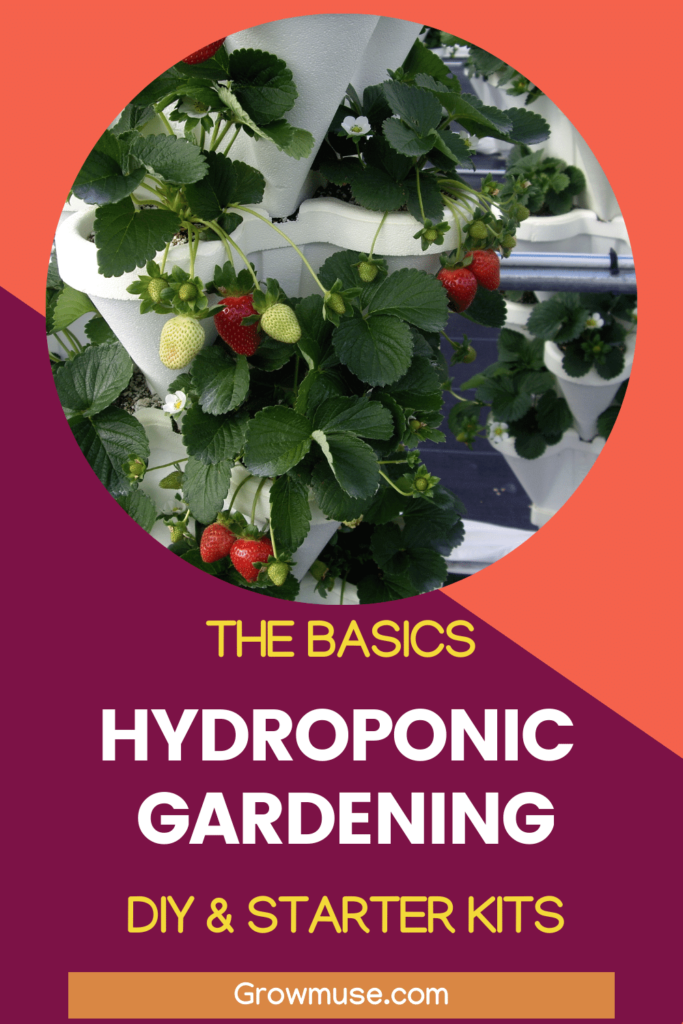
Any links on this page that lead to products on Amazon are affiliate links and I earn a commission if you make a purchase. Thanks in advance for your support! Read the full disclosure here.
If you’re a new gardener searching for no-mess, no- stress indoor gardening options, you may have stumbled upon hydroponic gardening. What is hydroponics, you ask? It’s basically growing plants without soil.
For someone who has never grown anything before, this might seem appealing. Without needing soil, it’s one less ingredient to worry about as you set up your new garden inside.
Sounds intriguing, right?
Table of Contents
Hydroponic Gardening Is Great For Beginners
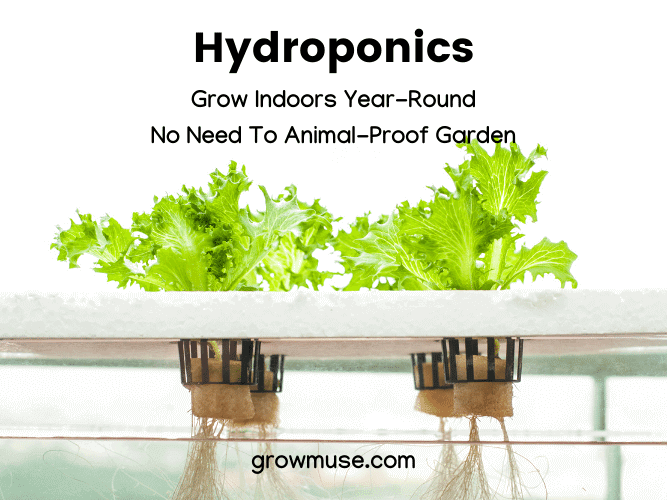
Not only do you not have to worry about soil with hydroponics, it can be really beneficial if you don’t have a yard to work with to start a garden.
Hydroponics allows you to grow year-round indoors regardless of what the weather is like outside.
Because you’re growing indoors, you also don’t have to worry about pesky squirrels, rabbits, cats, birds, or deer snatching up your harvest before you get to it.
Imagine a world where having fresh salad, herbs, and vegetables are at your fingertips. Can’t eat more local than this!
DIY Hydroponic Systems Vs. Hydroponic Starter Kits
I’m going to cover some of the most common ways gardeners set up hydroponic systems indoors.
I’ll share the easiest set and forget it Kratky method, to the very engineering-intensive Nutrient Film Technique.
Based on your budget, space, and time, there is an option for everyone.
If you like the idea of growing without soil but don’t have the time or energy to build your own hydroponics systems, skip down to my review of Hydroponics Starter Grow Kits where you can buy a kit.
These kits have everything you need to start gardening indoors right away!
What Is Hydroponics Again?
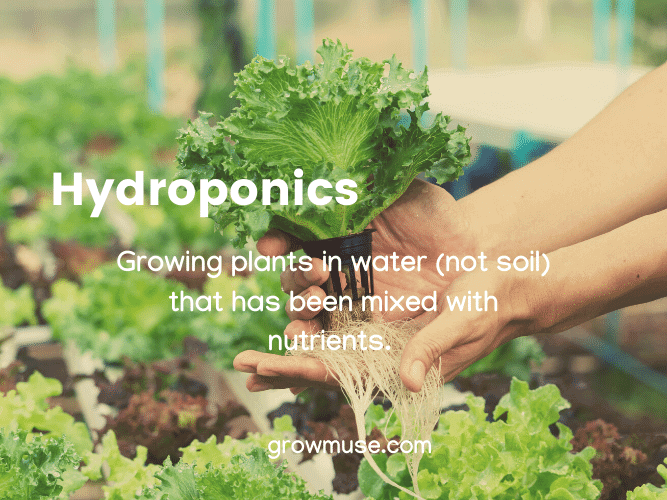
I’ll break down why you’d want to consider growing hydroponically, review the advantages and disadvantages, and finally the main components that make up a hydroponic growing system.
Hydroponics Definition
Hydroponics is a technique of growing plants in water (not soil) that has been mixed with nutrients. The plant roots are in water and take in all the dissolved nutrients.
Why Ditch the Soil When Growing?
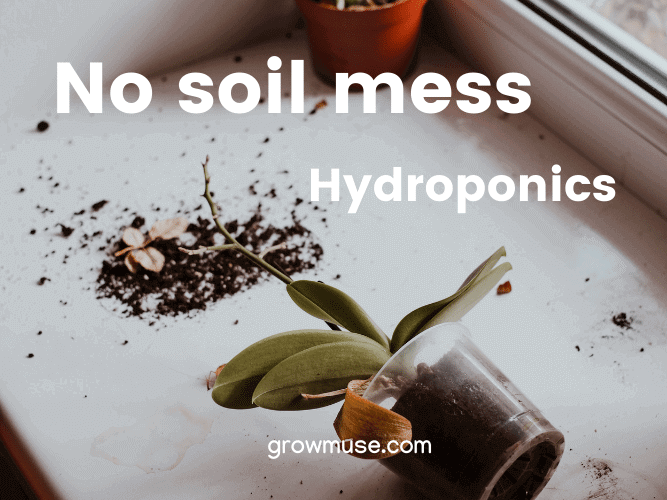
You can grow at any time of the year indoors. Climate change affects temperatures and growing conditions. With hydroponic growing, you can grow literally anywhere.
Hydro plants can mature up to 25 percent more quickly than the same plants grown in soil, with increased crop yield. That means more food on the table for you and your family.
Hydroponic systems can use less water (up to two-thirds water) than soil-based systems. Water can be filtered and recycled to use over and over again.
Advantages of Hydroponics Growing for Beginners
- Bigger harvest
- Less water required
- Requires less space
- Faster plant growth
- Great option if you don’t have a yard to grow outdoors
- Year-round growing
- Better animal management (no squirrels, birds, or deer indoors eating your harvest)
Disadvantages of Hydroponics Growing
- If using a DIY method, the set up can be time-consuming
- Very expensive
- If any part breaks, your plants are at risk
- Potential algae growth can damage a system
Components of Hydroponic Systems
- Fresh Water – Filtered water with balanced pH. You can adjust the acidity of water with solutions from the garden store to control the acid or alkaline levels.
- Oxygen: Using an air stone or air pump, you can oxygenate your plant container or leave room between the plant and the water source.
- Root Support: Plant roots need support from growing mediums like vermiculite, perlite, peat moss, coconut fiber, and rockwool.
- Nutrients: This is the plant food. You can add premixed solutions or powders containing magnesium, phosphorus, calcium, and other nutrients to plant water for plants to stay healthy and productive.
- Light: Indoor grow lights are necessary.
Choosing A Hydroponic System For Your Home
When choosing to grow hydroponically, you need to consider the following:
- Space in your home
- Cost of the unit and maintenance
- Time you have to monitor the garden
Below you’ll find some of the most common hydroponic systems you can build at home.
We’ve started with the easiest, most passive method first using the Kratky Method.
Kratky Method
The Kratky method doesn’t rely on pumps or electricity. It’s fairly simple to set up, and great for new growers and kids. One would go so far as to say this is a “hands off” growing method.
Simply place a young seedling onto a raft. The raft sits on top of a tank filled with water and nutrients.
As the plant roots grow longer, they take up more water. In doing so, this creates an air gap for the roots to breathe.
After a few weeks, you can harvest. You’ll notice the plant has taken up much of the water and nutrients.
This system works best with lettuce, leafy greens (spinach), and fast-growing herbs (basil, chive, mint).
Here’s how to set up a Kratky system at home using materials you already have or can find at the hardware store.
Deep Water Culture
Also referred to as DWC, this growing technique suspends plants in nutrient-rich water. As the seedlings grow, they will take in nutrients similar to the Kratky method.
The difference between DWC and Kratky is that with DWC, the roots are fully submerged in the water. To create an air zone, you can add an air stone or air pump to your water container.
Oxygen levels must be monitored; otherwise, there’s risk of root rot.
Here’s how to set up a deep water water culture system.
Ebb & Flow
Ebb and flow systems slowly flood the growing medium with nutrients and water. The solution is then returned to the reservoir.
You’ll need to use a submersible pump and timer to set up a schedule based on the number of plants, the size of those plants, and temperature to start.
The timer floods the grow bed at specific intervals.
As the solution returns back to the reservoir, the roots are exposed to oxygen.
Here’s how to set up your own Ebb and Flow system.
Nutrient Film Technique

We get more advanced and expensive with the Nutrient Film Technique (NFT). You will need to use a reservoir and a pump system.
Plants are placed on a slight angle so your nutrient solution can flow down the channel into the reservoir. As the water reaches the end of the line, it receives more nutrients and is pumped back to the beginning of the line.
This process repeats over and over again feeding the plants’ roots along the journey.
Monitoring your pump is very important. If it should ever fail, your roots can dry and you risk losing your crop.
Here’s how to set up a system using the Nutrient Film Technique.
Drip System
This drip system requires two pumps, a reservoir, and hoses to grow your plants.
The first air pump keeps the water and nutrients moving and oxygenated.
The second pump pushes the solution up through the hoses. These same hoses then drop nutrients into plants.
The water moves from top to bottom, so the roots are embedded in the medium, and not hanging freely like in the other systems.
Drip systems can get clogged, drying out plants.
Here’s how to set up a drip system.
9 Hydroponics Starter Grow Kits
If you liked the hydroponic techniques mentioned above, but don’t want to spend time building a system from scratch, read below.
I know when I was researching hydroponics systems, they all seemed to require a lot of monitoring and set up time. Some of the units were incredibly expensive too.
I find one of the biggest challenges for new gardeners is actually getting a system set up. If you have to go shopping for the soil, the seeds, the lights, the tools separately, that is a big hurdle.
It can certainly become overwhelming. There are too many steps involved.
What I’ve done below is research some of the best hydroponic gardening kits that include either 100% of what you need or come close to it.
The first four kits include seed pods. If you’re familiar with Nespresso or Keurig machines, getting your plants started is just as easy as making coffee. All you have to do is pop one of the plant pods into the unit to get growing.
Here are the best hydroponics starter grow kits that come assembled for you, starting with the most highly reviewed.
AeroGarden Bounty
This AeroGarden Bounty is high-tech and allows you to control the lighting and watering from your smart device. AeroGardens use a subset of hydroponics called aeroponics.
It comes with a 9-Pod Gourmet Herb Seed Pod Kit. You can get started growing Genovese Basil, Thai Basil, Curly Parsley, Italian Parsley, Thyme, Chives Dill, and Mint. Yummy!
The unit comes with a 6 inch tall trellis, so you can keep your plants upright and stabilized.
With the option to grow plants up to 24″ tall, this is an excellent indoor garden for beginners and more advanced gardeners.
The even cooler feature with the AeroGarden Bounty is its Vacation Mode. When turned on it uses 50% less water. This is really nice when you have to leave home and don’t want to ask someone to come in to water your plants.
Aerogarden Farm Plus
This is another option from Aerogarden with a smart aeroponics system. By connecting to your wi-fi, you can control your garden from your phone even when you’re not home.
The Farm Plus comes with full-spectrum LED lights, so you don’t have to purchase another accessory.
It can accommodate more plants than the AeroGarden Bounty, but has less tech features.
This particular unit comes with a 24 pack seed kit. It includes heirloom greens, herbs, and cherry tomatoes. Additionally, you’ll receive two 3oz bottles of their patented, all-natural Plant Nutrients, which is enough for a full season of growth!
The 24 inches of grow height allows for large, regular harvests. This is great if you want to grow taller plants in one section versus shorter ones in the other section.
Click and Grow Smart Garden
This made the list for its compact size. It definitely will fit on a tabletop anywhere in the house. It’s a great option for new gardeners who want to give hydroponic growing a try.
What’s nice is the system comes with basil plants, so you can start growing immediately. Basil is so versatile and used in a lot of recipes, so you definitely will make good use of it.
Once you’re finished harvesting basil, you can purchase more of their 50 additional pre-seeded pods to pop into the system and start growing more food.
Pre-seeded pods include plants like cilantro, basil, lavender, wild strawberries, thyme, and even chili peppers.
If you’re concerned with watering, you don’t have to with this unit. The water reservoir will water your crops for a month! So go on about your busy days. This is just one less thing to worry about.
AeroGarden Harvest 360
Yes, we have another AeroGarden unit to share. This is an all-inclusive system with seeds for herbs, plant nutrients, and grow lights attached.
Unlike the AeroGarden Bounty and Farm Plus, which can grow plants up to 24 inches tall, this unit maxes out at 12 inches.
This unit fits up to 6 plants. The package comes with Genovese Basil, Curly Parsley, Dill, Thyme, Thai Basil and Mint and a 3oz bottle of natural plant nutrients.
This AeroGarden Harvest 360 doesn’t lack in the tech space. The control panel tells you when to add water, reminds you when to add plant food, and even automatically turns lights on and off.
This really is a great system if you want to be hands off, get started quickly without needing to purchase additional accessories, and want to grow shorter plant varieties.
Lettuce Grow Farmstand
This is a seriously cool garden system. People love it because you can start small growing 12 plants at a time. This includes veggies, herbs, and leafy greens. Then as you build some confidence growing, you can add more tiers (with 6 more varieties). The most you can plant is 36 plants!
If you’re growing indoors, you’ll need to buy the Lettuce Grow Glow Rings for each tier. This can get costly when you’re adding it all up, but could be worth the investment depending on what you’re looking to grow in an all-in-on system.
The other advantage this system has for beginners is that you can purchase seedlings from Lettuce Grow. This gives you a jump start in growing versus starting from seed pods, because the plants are pre-sprouted!
This means fresh food on your plate faster.
There’s also an app (only available for iOS) to alert you when it’s time to harvest and order more seedlings. Forgot what you planted? The app can identify your plants and provide growing info for you.
SavvyGrow Vertical Herb Garden
I included the SavvyGrow Garden because the possibilities with this unit are endless given the growing space.
You get everything you need to grow your own organic food & herbs. The kit includes seeds, nutrients, airstone, powerful air pump & a medium sized DWC bucket, water indicator, tube & clay pebbles.
Don’t worry about having enough light, because there are LED light bars for every level ensuring your plants get the sunlight they need.
This unit is a lot larger compared to others on this list, but it grows vertically so you just have to find enough space for the height.
This system is ideal if you are serious about growing a lot.
Moistenland Hydroponics Growing System
The Moistenland system is nice because it comes with 12 planting seed pods which are made of Biochar Mud. Studies have shown that using biochar can increase crop yields and growth. That’s cool!
There’s an automatic control panel to turn the LED grow light off after 18 hours of constant use. This means you don’t have to worry about setting a light timer to turn your lights on/off.
The Dual Growing Mode setting allows you to grow vegetables and flower fruits at the same time.
A built-in fan is also a nice feature, which mimics wind in nature to help plants grow.
I included this growing system if you’re interested in growing unique plant varieties not found in one of the kits above. You’ll have more flexibility and customization but will need to purchase seeds and nutrient solutions separately.
Dreamjoy Ebb & Flow System
This Dreamjoy system will hold up to a whopping 36 seedlings. It’s particularly good for leafy greens and vegetables.
Many reviews mention this unit as being very easy to assemble.
If you’re the type of gardener who wants a mini DIY, this system could be for you.
You’ll need to set up a grow light system above the Dreamjob and purchase your own unique seed varieties to plant.
Hydrofarm Ebb & Flow System
If you are interested in growing fruit, the Hydrofarm system could be a good option to look into.
This comes with a tray, 5-inch pots, fire-clay and pebble media.
You simply hook up the system and it will pump the nutrient solution from the reservoir to the plants.
This system is good if you want more control over your growing situation. You’ll need to purchase grow lights and seeds for this unit, making it an excellent choice for growing different fruit varieties indoors!
Final Thoughts: Which Hydroponics Grow System Will You Choose?
If you’ve made it this far, that means you’re really motivated or interested in starting a hydroponic garden. What are you waiting for now?
You can take path one. Click on the links above to buy one of the hydroponics starter kits. You will literally have fresh food within weeks. Follow the instructions on the unit and you’re all set!
You can choose to take path two. Spend a little more time building your own hydroponic system using one of the five popular setups described earlier.
If you’ve always wanted to grow your own lettuce, herbs, vegetables, or fruit at home, hydroponics is one of the easiest ways to get started.
Which path will you take to start hydroponically growing your own food at home?
Once you have your starter kit installed and set up, you’ll start seeing your plants grow, and be inspired to continue on the gardening path.
I assure you. You’ll get encouraged by your own plant growth at home. Your mind and hungry belly will not regret it!
Let me know in the comments what method you’re interested in and if you decide to start growing hydroponically!
Growmuse.com is a participant in the Amazon Services LLC Associates Program, an affiliate advertising program designed to provide a means for sites to earn commission by linking to Amazon.com. This is done at no cost to you. Read the full disclosure here.
What is hydroponics?
A technique of growing plants in water (not soil) that has been mixed with nutrients. The plant roots are in water and take in all the dissolved nutrients.
What are the advantages of hydroponics?
Bigger harvest
Less water required
Requires less space
Faster plant growth
Great option if you don’t have a yard to grow outdoors
Year-round growing
Better animal management (no squirrels, birds, or deer indoors eating your harvest)
What are the disadvantages of hydroponics?
If using a DIY method, the set up can be time-consuming
Very expensive
If any part breaks, your plants are at risk
Potential algae growth can damage a system
What are popular hydroponics systems?
Kratky Method, Deep Water Culture, Ebb & Flow, Nutrient Film Technique, Drip System



